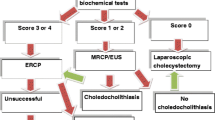Abstract
Background
To provide optimal selection of patients for preoperative endoscopic retrograde cholangiopancreatography or intraoperative cholangiography, we evaluated simple, noninvasive biochemical parameters as screening tests to predict the absence of common bile duct stones prior to laparoscopic cholecystectomy.
Methods
A total of 1002 patients underwent laparoscopic cholecystectomy. Five biochemical parameters were measured preoperatively: gamma glutamyl transferase (GGT), alkaline phosphatase, total bilirubin, alanine aminotransferase, and aspartate aminotransferase. Conventional diagnostic tests, including ultrasound imaging, computed tomography, magnetic resonance imaging, common bile duct diameter, endoscopic retrograde cholangiopancreatography, and serum amylase were performed. Along with the five biochemical tests above, these diagnostic tests were scrutinized and compared as potential predictors for common bile duct stones.
Results
Eighty-eight (8.8%) patients with gallstone disease who underwent laparoscopic cholecystectomy had concurrent common bile duct stones. Among all diagnostic tests, endoscopic retrograde cholangiopancreatography had the highest sensitivity (96.0%), specificity (99.1%), probability ratio (107.3), accuracy (98.0%), and positive predictive value (98.8%) in detecting common bile duct stones. At least one abnormal elevation among the five biochemical parameters had the highest sensitivity (87.5%). Total bilirubin had the highest specificity (87.5%), highest probability ratio (3.9), highest accuracy (84.1%), and highest positive predictive value (27.4%). All five biochemical predictors had high negative predictive values; gamma glutamyl transferase was highest (97.9%), while the lowest was total bilirubin (94.7%). Multivariate analysis showed only gamma glutamyl transferase, alkaline phosphatase, and total bilirubin to be independent predictors; gamma glutamyl transferase appeared to be the most powerful predictor (odds ratio 3.20).
Conclusion
Biochemical tests, especially gamma glutamyl transferase with 97.9% negative predictive value, are ideal noninvasive predictors for the absence of common bile duct stones in patients undergoing laparoscopic cholecystectomy. We suggest that unnecessary, costly, or risky procedures such as endoscopic retrograde cholangiopancreatography can be omitted prior to laparoscopic cholecystectomy in patients without abnormal elevation of these biochemical values.
Similar content being viewed by others
References
Barkun AN, Barkun JS, Fried GM, et al. (1994) Useful predictors of bile duct stones in patients undergoing laparoscopic cholecystectomy. Ann Surg 220: 32–39
NIH consensus development panel on gallstones and laparoscopic cholecystectomy (1993) Gallstones and laparoscopic cholecystectomy. JAMA 269: 1018–1024
Santucci L, Natalini G, Sarpi L, et al. (1996) Selective endoscopic retrograde cholangiography and preoperative bile duct stone removal in patients scheduled for laparoscopic cholecystectomy: a prospective study. Am J Gastroenterol 91: 1326–1330
Shiozawa S, Tsuchiya A, Kim DH, et al. (2005) Useful predictive factors of common bile duct stones prior to laparoscopic cholecystectomy for gallstones. Hepato-Gastroenterol 52: 1662–1665
Houdart R, Perniceni T, Darne B, et al. (1995) Predicting common bile duct lithiasis: determination and prospective validation of a model predicting low risk. Am J Surg 170: 38–43
Saltzstein EC, Peacock JB, Thomas MD (1982) Preoperative bilirubin, alkaline phosphatase and amylase levels as predictors of common duct stones. Surg Gynecol Obstet 154: 381–384
Onken JE, Brazer SR, Eisen GM, et al. (1996) Predicting the presence of choledocholithiasis in patients with symptomatic cholelithiasis. Am J Gastroenterol 91: 762–767
Korman J, Cosgrove J, Furman M, et al. (1996) The role of endoscopic retrograde cholangiopancreatography and cholangiography in the laparoscopic era. Ann Surg 223: 212–216
Clair DG, Carr-Locke DL, Becker JM, et al. (1993) Routine cholangiography is not warranted during laparoscopic cholecystectomy. Arch Surg 128:551–555
Wu SC, Chen FC, Lo CJ (2005) Selective intraoperative cholangiography and single-stage management of common bile duct stone in laparoscopic cholecystectomy. World J Surg 29: 1402–1408
Coppola R, Riccioni ME, Ciletti S, et al. (2001) Selective use of endoscopic retrograde cholangiopancreatography to facilitate laparoscopic cholecystectomy without cholangiography. A review of 1139 consecutive cases. Surg Endosc 15: 1213–1216
Cotton PB, Baillie H, Pappas TN, et al. (1991) Laparoscopic cholecystectomy and the biliary endoscopist. Gastrointest Endosc 37: 94–97
Neuhaus H, Feussner H, Ungeheuer A, et al. (1992) Prospective evaluation of the use of endoscopic retrograde cholangiography prior to laparoscopic cholecystectomy. Endoscopy 24: 745–749
Johnson AG, Hosking SW (1987) Appraisal of the management of bile duct stones. Br J Surg 74: 555–560
Abboud PC, Malet PF, Berlin JA, et al. (1996) Predictors of common bile duct stones prior to choelcystectomy: a meta-analysis. Gastrointest Endosc 44: 450–459
Kama NA, Atli M, Doganay M, et al. (2001) Practical recommendations for the prediction and management of common bile duct stones in patients with gallstones. Surg Endosc 15: 942–945
Prat F, Meduri B, Ducot B, et al. (1999) Prediction of common bile duct stones by noninvasive tests. Ann Surg 229: 362–368
Daradkeh S, Shennak M, Abu-Khalaf M (2000) Selective use of perioperative ERCP in patients undergoing laparoscopic cholecystectomy. Hepato-Gastroenterology 47: 1213–1215
Frey CF, Burbige EJ, Meinke WB, et al. (1982) Endoscopic retrograde cholangiopancreatography. Am J Surg 144: 109–104
Tse F, Barkun JS, Romagnuolo J, et al. (2006) Nonoperative imaging techniques in suspected biliary tract obstruction. HPB 8: 409–425
Author information
Authors and Affiliations
Corresponding author
Rights and permissions
About this article
Cite this article
Yang, MH., Chen, TH., Wang, SE. et al. Biochemical predictors for absence of common bile duct stones in patients undergoing laparoscopic cholecystectomy. Surg Endosc 22, 1620–1624 (2008). https://doi.org/10.1007/s00464-007-9665-2
Received:
Revised:
Accepted:
Published:
Issue Date:
DOI: https://doi.org/10.1007/s00464-007-9665-2




